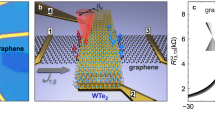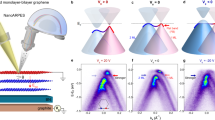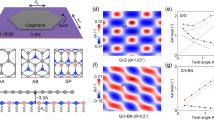Abstract
Twist engineering has emerged as a powerful approach for modulating electronic properties in van der Waals heterostructures. While theoretical works have predicted the modulation of spin texture in graphene-based heterostructures by twist angle, experimental studies are lacking. Here, by performing spin precession experiments, we demonstrate tunability of the spin texture and associated spin–charge interconversion with twist angle in WSe2/graphene heterostructures. For specific twist angles, we detect a spin component radial with the electron’s momentum, in addition to the standard orthogonal component. Our results show that the helicity of the spin texture can be reversed by twist angle, highlighting the critical role of the twist angle in the spin–orbit properties of WSe2/graphene heterostructures and paving the way for the development of spin-twistronic devices.
This is a preview of subscription content, access via your institution
Access options
Access Nature and 54 other Nature Portfolio journals
Get Nature+, our best-value online-access subscription
$29.99 / 30 days
cancel any time
Subscribe to this journal
Receive 12 print issues and online access
$259.00 per year
only $21.58 per issue
Buy this article
- Purchase on SpringerLink
- Instant access to full article PDF
Prices may be subject to local taxes which are calculated during checkout





Similar content being viewed by others
Data availability
Source data in the paper are available via figshare at https://doi.org/10.6084/m9.figshare.24616287. Any further data and codes used in this study are available from corresponding authors upon reasonable request.
Code availability
Source data in the paper are available via figshare at https://doi.org/10.6084/m9.figshare.24616287. Any further data and codes used in this study are available from corresponding authors upon reasonable request.
References
Ribeiro-Palau, R. et al. Twistable electronics with dynamically rotatable heterostructures. Science 361, 690–693 (2018).
Andrei, E. Y. & MacDonald, A. H. Graphene bilayers with a twist. Nat. Mater. 19, 1265–1275 (2020).
Kennes, D. M. et al. Moiré heterostructures as a condensed-matter quantum simulator. Nat. Phys. 17, 155–163 (2021).
Serlin, M. et al. Intrinsic quantized anomalous Hall effect in a moiré heterostructure. Science 367, 900–903 (2020).
Zheng, Z. et al. Unconventional ferroelectricity in moiré heterostructures. Nature 588, 71–76 (2020).
Lin, J. X. et al. Spin–orbit-driven ferromagnetism at half moiré filling in magic-angle twisted bilayer graphene. Science 375, 437–441 (2022).
Tschirhart, C. L. et al. Intrinsic spin Hall torque in a moiré Chern magnet. Nat. Phys. 19, 807–813 (2023).
Tao, Z. et al. Giant spin Hall effect in AB-stacked MoTe2/WSe2 bilayers. Nat. Nano. 19, 28–24 (2024).
Cao, Y. et al. Unconventional superconductivity in magic-angle graphene superlattices. Nature 556, 43–50 (2018).
Sun, L. et al. Determining spin–orbit coupling in graphene by quasiparticle interference imaging. Nat. Commun. 14, 3771 (2023).
Ingla-Aynés, J., Meijerink, R. J. & Wees, B. J. V. Eighty-eight percent directional guiding of spin currents with 90 μm relaxation length in bilayer graphene using carrier drift. Nano Lett. 16, 4825–4830 (2016).
Drögeler, M. et al. Spin lifetimes exceeding 12 ns in graphene nonlocal spin valve devices. Nano Lett. 16, 3533–3539 (2016).
Yang, H. et al. Gate-tunable spin Hall effect in an all-light-element heterostructure: graphene with copper oxide. Nano Lett. 23, 4406–4414 (2023).
Ontoso, N. et al. Unconventional charge-to-spin conversion in graphene/MoTe2 van der Waals heterostructures. Phys. Rev. Appl. 19, 014053 (2023).
Ghiasi, T. S., Kaverzin, A. A., Blah, P. J. & Van Wees, B. J. Charge-to-spin conversion by the Rashba–Edelstein effect in two-dimensional van der Waals heterostructures up to room temperature. Nano Lett. 19, 5959–5966 (2019).
Gmitra, M., Kochan, D. & Fabian, J. Spin–orbit coupling in hydrogenated graphene. Phys. Rev. Lett. 110, 246602 (2013).
Weeks, C., Hu, J., Alicea, J., Franz, M. & Wu, R. Engineering a robust quantum spin Hall state in graphene via adatom deposition. Phys. Rev. X 1, 021001 (2011).
Gmitra, M., Kochan, D., Högl, P. & Fabian, J. Trivial and inverted Dirac bands and the emergence of quantum spin Hall states in graphene on transition-metal dichalcogenides. Phys. Rev. B 93, 155104 (2016).
Calleja, F. et al. Spatial variation of a giant spin–orbit effect induces electron confinement in graphene on Pb islands. Nat. Phys. 11, 43–47 (2015).
Safeer, C. K. et al. Reliability of spin-to-charge conversion measurements in graphene-based lateral spin valves. 2D Mater. 9, 015024 (2022).
Ingla-Aynés, J. et al. Omnidirectional spin-to-charge conversion in graphene/NbSe2 van der Waals heterostructures. 2D Mater. 9, 045001 (2022).
Ingla-Aynés, J., Herling, F., Fabian, J., Hueso, L. E. & Casanova, F. Electrical control of valley-Zeeman spin–orbit-coupling–induced spin precession at room temperature. Phys. Rev. Lett. 127, 047202 (2021).
Herling, F. et al. Gate tunability of highly efficient spin-to-charge conversion by spin Hall effect in graphene proximitized with WSe2. APL Mater. 8, 071103 (2020).
Safeer, C. K. et al. Spin Hall effect in bilayer graphene combined with an insulator up to room temperature. Nano Lett. 20, 4573–4579 (2020).
Safeer, C. K. et al. Room-temperature spin Hall effect in graphene/MoS2 van der waals heterostructures. Nano Lett. 19, 1074–1082 (2019).
Safeer, C. K. et al. Large multidirectional spin-to-charge conversion in low-symmetry semimetal MoTe2 at room temperature. Nano Lett. 19, 8758–8766 (2019).
Benítez, L. A. et al. Tunable room-temperature spin galvanic and spin Hall effects in van der Waals heterostructures. Nat. Mater. 19, 170–175 (2020).
Pham, V. T. et al. Spin–orbit magnetic state readout in scaled ferromagnetic/heavy metal nanostructures. Nat. Electron. 3, 309–315 (2020).
Manipatruni, S. et al. Scalable energy-efficient magnetoelectric spin–orbit logic. Nature 565, 35–42 (2019).
Yang, H. et al. Two-dimensional materials prospects for non-volatile spintronic memories. Nature 606, 663–673 (2022).
Lin, C. C. et al. Spin transfer torque in a graphene lateral spin valve assisted by an external magnetic field. Nano Lett. 13, 5177–5181 (2013).
Cummings, A. W., Garcia, J. H., Fabian, J. & Roche, S. Giant spin lifetime anisotropy in graphene induced by proximity effects. Phys. Rev. Lett. 119, 206601 (2017).
Offidani, M., Milletarì, M., Raimondi, R. & Ferreira, A. Optimal charge-to-spin conversion in graphene on transition-metal dichalcogenides. Phys. Rev. Lett. 119, 196801 (2017).
Garcia, J. H., Cummings, A. W. & Roche, S. Spin Hall effect and weak antilocalization in graphene/transition metal dichalcogenide heterostructures. Nano Lett. 17, 5078–5083 (2017).
Milletarì, M., Offidani, M., Ferreira, A. & Raimondi, R. Covariant conservation laws and the spin Hall effect in Dirac–Rashba systems. Phys. Rev. Lett. 119, 246801 (2017).
Garcia, J. H., Vila, M., Cummings, A. W. & Roche, S. Spin transport in graphene/transition metal dichalcogenide heterostructures. Chem. Soc. Rev. 47, 3359–3379 (2018).
Lee, S. et al. Charge-to-spin conversion in twisted graphene/WSe2 heterostructures. Phys. Rev. B 106, 165420 (2022).
Li, Y. & Koshino, M. Twist-angle dependence of the proximity spin–orbit coupling in graphene on transition-metal dichalcogenides. Phys. Rev. B 99, 075438 (2019).
Naimer, T., Zollner, K., Gmitra, M. & Fabian, J. Twist-angle dependent proximity induced spin–orbit coupling in graphene/transition metal dichalcogenide heterostructures. Phys. Rev. B 104, 195156 (2021).
David, A., Rakyta, P., Kormányos, A. & Burkard, G. Induced spin–orbit coupling in twisted graphene–transition metal dichalcogenide heterobilayers: twistronics meets spintronics. Phys. Rev. B 100, 085412 (2019).
Veneri, A., Perkins, D. T. S., Péterfalvi, C. G. & Ferreira, A. Twist angle controlled collinear Edelstein effect in van der Waals heterostructures. Phys. Rev. B 106, L081406 (2022).
Péterfalvi, C. G., David, A., Rakyta, P., Burkard, G. & Kormányos, A. Quantum interference tuning of spin–orbit coupling in twisted van der Waals trilayers. Phys. Rev. Res. 4, L022049 (2022).
Bihlmayer, G., Noël, P., Vyalikh, D. V., Chulkov, E. V. & Manchon, A. Rashba-like physics in condensed matter. Nat. Rev. Phys. 4, 642–659 (2022).
Calavalle, F. et al. Gate-tuneable and chirality-dependent charge-to-spin conversion in tellurium nanowires. Nat. Mater. 21, 526–532 (2022).
Camosi, L. et al. Resolving spin currents and spin densities generated by charge-spin interconversion in systems with reduced crystal symmetry. 2D Mater. 9, 035014 (2022).
Li, Y. et al. Probing symmetry properties of few-layer MoS2 and h-BN by optical second-harmonic generation. Nano Lett. 13, 3329–3333 (2013).
Mennel, L., Paur, M. & Mueller, T. Second harmonic generation in strained transition metal dichalcogenide monolayers: MoS2, MoSe2, WS2, and WSe2. APL Photonics 4, 034404 (2019).
You, Y., Ni, Z., Yu, T. & Shen, Z. Edge chirality determination of graphene by Raman spectroscopy. Appl. Phys. Lett. 93, 163112 (2008).
Krauss, B. et al. Raman scattering at pure graphene zigzag edges. Nano Lett. 10, 4544–4548 (2010).
Zollner, K., João, S. M., Nikolić, B. K. & Fabian, J. Twist- and gate-tunable proximity spin–orbit coupling, spin relaxation anisotropy, and charge-to-spin conversion in heterostructures of graphene and transition metal dichalcogenides. Phys. Rev. B 108, 235166 (2023).
Acknowledgements
We acknowledge funding from the ‘Valleytronics’ Intel Science Technology Center; from the Spanish MICIU/AEI/10.13039/501100011033 (‘Maria de Maeztu’ Units of Excellence Programme grant no. CEX2020-001038-M); from MICIU/AEI and ERDF/EU (project nos. PID2021-122511OB-I00 and PID2021-128004NB-C21); from Diputación de Gipuzkoa (project no. 2021-CIEN-000037-01); from the European Union’s Horizon 2020 research and innovation programme under the Marie Skłodowska-Curie grant agreement no. 955671. Z.C. acknowledges support from the ‘Juan de la Cierva’ Programme by the Spanish MICIU/AEI and European Union NextGenerationEU/PRTR (grant no. FJC2021-047257-I). H.Y. acknowledges support from NSFC 92164206 and 52261145694. B.M.-G. and M.G. acknowledge support from the ‘Ramón y Cajal’ Programme by the Spanish MICIU/AEI and European Union NextGenerationEU/PRTR (grant nos. RYC2021-034836-I and RYC2021-031705-I, respectively). CzechNanoLab project LM2023051 funded by MEYS CR is gratefully acknowledged for the financial support of the measurements at LNSM Research Infrastructure.
Author information
Authors and Affiliations
Contributions
H.Y. and F.C. conceived the study. H.Y. fabricated the samples, with help from E.D. and Z.C. H.Y. performed the electrical measurements and the data were analysed by H.Y., M.G., L.E.H. and F.C. B.M.-G. and H.Y. performed the Raman spectroscopy measurements. E.S., J.K. and P.N. performed the optical SHG experiments. All authors contributed to the discussion of the results and their interpretation. H.Y. and F.C. wrote the manuscript with input from all authors.
Corresponding authors
Ethics declarations
Competing interests
The authors declare no competing interests.
Peer review
Peer review information
Nature Materials thanks Ahmet Avsar and the other, anonymous, reviewer(s) for their contribution to the peer review of this work.
Additional information
Publisher’s note Springer Nature remains neutral with regard to jurisdictional claims in published maps and institutional affiliations.
Supplementary information
Supplementary Information
Supplementary Notes 1–13.
Rights and permissions
Springer Nature or its licensor (e.g. a society or other partner) holds exclusive rights to this article under a publishing agreement with the author(s) or other rightsholder(s); author self-archiving of the accepted manuscript version of this article is solely governed by the terms of such publishing agreement and applicable law.
About this article
Cite this article
Yang, H., Martín-García, B., Kimák, J. et al. Twist-angle-tunable spin texture in WSe2/graphene van der Waals heterostructures. Nat. Mater. (2024). https://doi.org/10.1038/s41563-024-01985-y
Received:
Accepted:
Published:
DOI: https://doi.org/10.1038/s41563-024-01985-y



